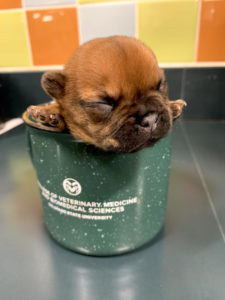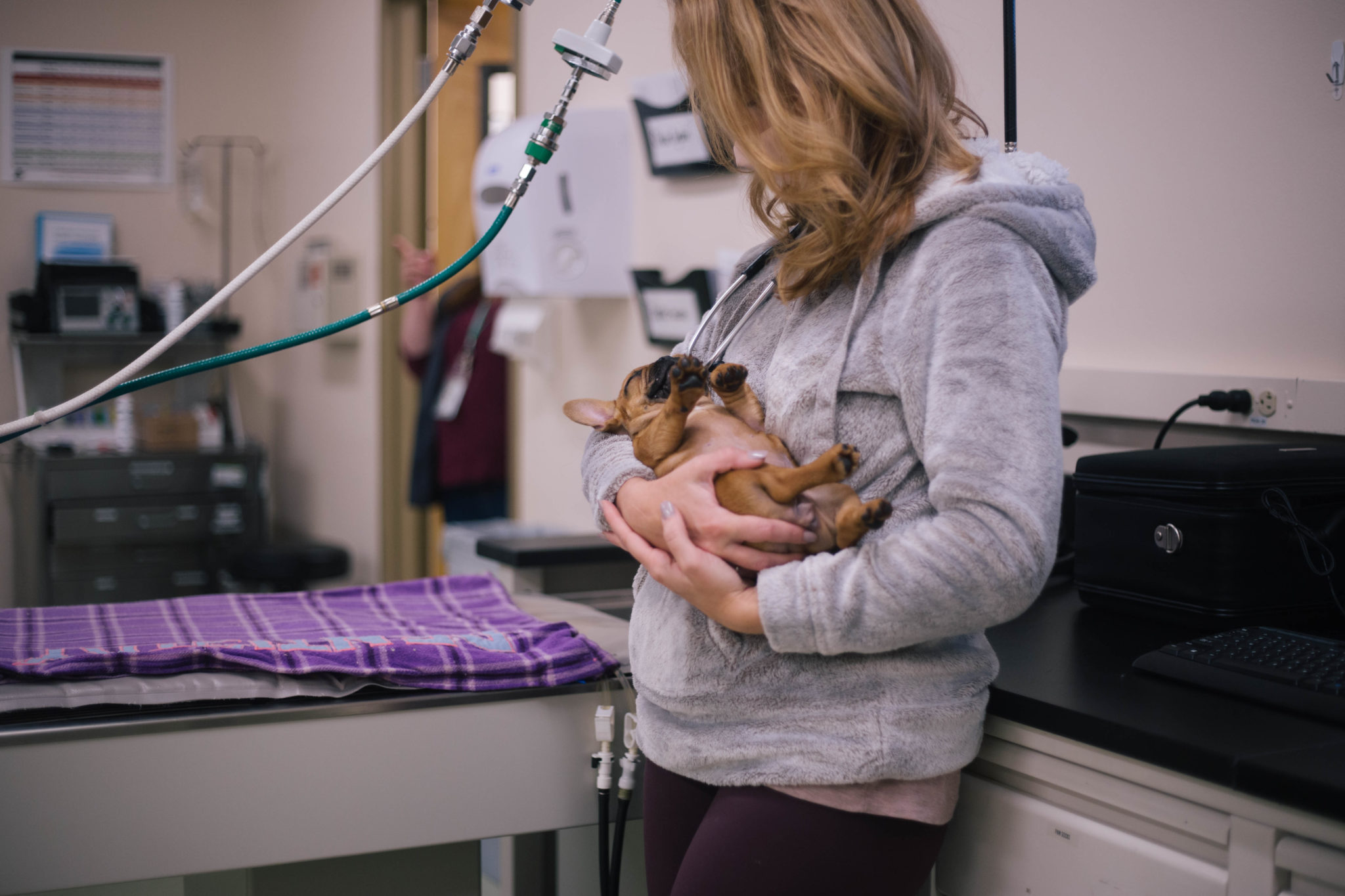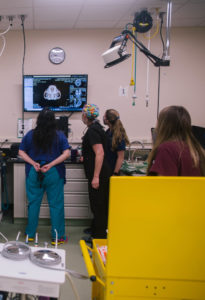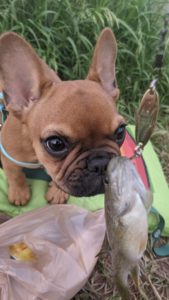By Jessica Cox
When Miss Charlie Brown was born, she weighed 280 grams and fit perfectly inside of a coffee mug. She was also in the minority five percent of puppies born with a cleft palate, or a hole in the roof of the mouth. Cleft palate is even more common among brachycephalic breeds, which includes Charlie, who is a French bulldog. Her chances of survival weren’t high.

Cleft palate is a condition that results when the two halves of the roof of the mouth do not grow together completely, leaving a hole that leads directly to the nasal passages. Eating and swallowing are difficult, because risk of aspiration – when food or fluid is breathed into the airways – is high.
“Heads develop separately in two halves, then get fused together,” said Dr. Naomi Hoyer, a board-certified veterinary dentist and the Dentistry and Oral Surgery service coordinator at the James L. Voss Veterinary Teaching Hospital. “During the fusion process with cleft palates, the nasal processes don’t get the memo to stop being two separate things and just be one thing.”
Many puppies with cleft palate don’t survive long because of the associated health risks. Due to the high cost and variable success rate of repair surgery, others are euthanized because breeders or owners aren’t willing to dedicate the time and money necessary to properly care for a cleft palate puppy.
Katie Doyon happened to be working in the critical care unit the day Charlie was born via emergency C-section. She’s a certified veterinary technician and the critical care supervisor at the Veterinary Teaching Hospital. She also runs Mended Hearts Rescue & Fund with her co-founder Karissa Ochs, also a veterinary technician in the critical care unit. When Charlie was in recovery among the rest of the litter, Doyon learned she was going to be euthanized because of her cleft palate.
“I decided I’d step in and take her on,” Doyon said. “It was under the expectation that she wouldn’t survive, but I wanted to give her a chance.”
Doyon ran down to the dentistry and oral surgery service to ask Dr. Hoyer if Charlie’s cleft palate was even something that could be fixed. Hoyer was optimistic.
“Dr. Hoyer said ‘it’s worth a shot, so let’s give it a chance,’” Doyon said. “Our goal was to get Charlie to at least 4 pounds or 8 weeks old, so we worked very hard to get her to that point so we could schedule surgery.”

Bringing two halves together
Reconstructive surgery involves lifting the oral tissue up off the bone on the roof of the mouth and suturing it together in the middle to cover up the hole. Soft tissue inside the mouth is limited, but as puppies grow, their soft tissue does, too. Waiting several weeks for Charlie to grow provided more material for Hoyer to work with, ensuring a higher chance of surgical success.
Getting Charlie to that point, though, was no easy task. Puppies with cleft palate can struggle with failure to grow normally and are particularly susceptible to aspiration pneumonia. Charlie needed around-the-clock nursing care and hourly feedings via a feeding tube. During her first few weeks of life she experienced close calls with a skin infection and aspiration pneumonia.
“The hospital community fell in love with her and everyone was invested,” Doyon said. “At one point we thought we’d have to euthanize her, but care from the different departments got her through her ups and downs.”

At 12 weeks old, Charlie had surgery to repair her cleft palate. While much of the defect can be seen with the naked eye, a CT scan on the day of surgery showed how extensive the lesion was in the bone. Sometimes cleft palate can be associated with other brain and skull abnormalities, but Hoyer didn’t observe any of those, which meant a better prognosis after surgery.
“Palate surgeries are very challenging. There’s not great blood supply to the palate and you have to preserve the arteries during surgery,” Hoyer said.
Proper anesthesia is crucial to surgical success, especially for patients as small as Charlie. Anesthesiologist Dr. Gregg Griffenhagen developed a comprehensive anesthesiology plan and Holly Ellis, an anesthetist, was with Charlie every step of the way, monitoring her vitals to ensure her safety throughout surgery and postoperative recovery.
“The anesthesia department goes above and beyond anesthetizing these very tiny, very critically fragile patients,” Doyon said. “They deserve major kudos for keeping Charlie safe during surgery.”
Postoperatively, the most common complication from cleft palate surgery is that it doesn’t heal all the way, and preventing aspiration and pneumonia continues to be important during the healing process.
“Our goal isn’t for it to be perfect,” Hoyer said. “It’s for these puppies to get to live a clinically normal life where they can eat, drink, run around, and chew on things.”
After two weeks, success of the surgery becomes clearer, as risk of complications drops. Charlie cleared that goal, and while there’s a small area in her mouth that didn’t heal all the way, she’s doing great.

A Frenchie forever home
While Doyon made it her mission to give Charlie a chance, it wasn’t necessarily in her plan to adopt her. But after spending five months taking care of and falling in love with her, Doyon was faced with making a tough decision.

“The idea of animals being disposable doesn’t sit right with my heart, which is why we took her on in the first place,” Doyon said. “I feel like she came into our family for a reason.”
Doyon noted that while Charlie is special, her story is not uncommon. Cleft palate is only one of several medical complications that more commonly occur in brachycephalic breeds like French bulldogs. Oftentimes these animals are bred without concern for the risk of these complications and the subsequent medical costs incurred, leading to euthanasia when owners or breeders cannot afford the price of emergency care.
After months of round-the-clock nursing care, several medical interventions, cleft palate repair, and upcoming airway and spay surgeries, Charlie’s medical bills will exceed $4,000; an amount that, for brachycephalic breeds, is not altogether unheard of.
“At Mended Hearts, we work hard to give animals the resources they need to overcome medical hurdles and find homes that will accept the lifelong commitment of owning a pet,” Doyon said.
Not every Frenchie is so fortunate. Charlie is one of the lucky ones.
Miss Charlie Brown’s care team included faculty, staff, and students from across the James L. Voss Veterinary Teaching Hospital. Services who helped with Charlie’s case include Anesthesia and Pain Management; Dentistry and Oral Surgery; Dermatology and Otology; Diagnostic Imaging; Small Animal Critical Care; and Small Animal Reproduction.